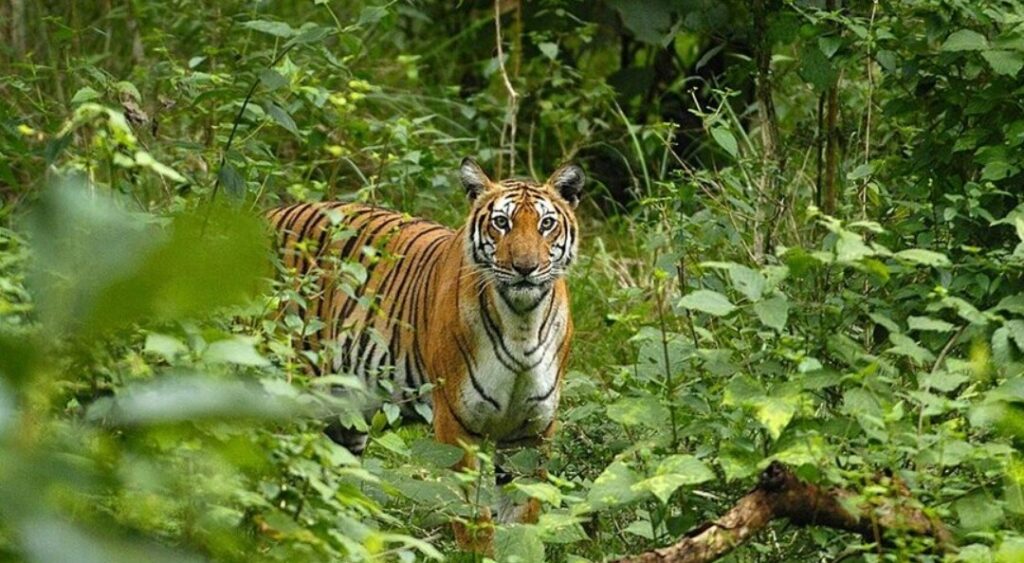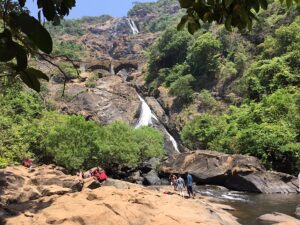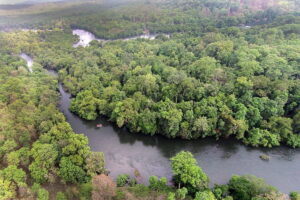Coal Corridor Or Tiger Corridor: The Battle Over Rail Expansion
Oct 22, 2025 | Pratirodh Bureau
A tiger in the Western Ghats. A Wildlife Institute of India study recorded five large to medium-sized carnivores, including tigers, along the track corridor in the area (Image by Kalyan Varma via Wikimedia Commons)
- The railways have planned to double an existing single railway line from Hospet in Karnataka to Vasco da Gama port in Goa, opening it up for coal transport.
- A portion of the upcoming line will run through the Kali Tiger Reserve in Karnataka and Goa’s Bhagwan Mahavir Wildlife Sanctuary and Mollem National Park.
- Conservationists are engaged in a legal battle to contain infrastructure penetration, maintain the corridor’s integrity, and designate the Goa areas as a tiger reserve.
As the Central Government steams ahead with its plan to double an existing railway line between Goa and Karnataka for coal transport, it has clashed with conservationists over a 26-kilometre stretch cutting through two wildlife sanctuaries in the Western Ghats which are known to have tigers.

An environment impact assessment notes that there is a presence of tigers, leopards, and other animals along the track corridor. The assessment was carried out by the Wildlife Institute of India (WII), commissioned by the Rail Vikas Nigam Ltd (RVNL), the implementing public sector entity for the Indian Railways.
“Adult tigers with cubs were (camera) captured in 5 locations”; “common leopards in multiple locations”, “sloth bears with cubs in numerous places”; besides “significant captures” of wild herbivores like gaur, sambhar, mouse deer, northern red muntjac or barking deer and wild boar, the assessment states.
The current single railway line runs for 345 km from Hospet in Karnataka to Vasco da Gama in Goa.
The proposed double line is to open up a coal transport corridor between these two areas. About 26 km of this line will run from Castlerock on Karnataka’s border to Kulem on the Goa border. Almost ten hectares of forest land in Karnataka’s Dandeli wildlife sanctuary (part of the Kali Tiger Reserve, along with the Anshi wildlife sanctuary) and over 120 hectares in Goa’s Bhagwan Mahaveer wildlife sanctuary and Mollem National Park is sought to be diverted for this additional track.
The current single line was first constructed in 1890 by a joint British and Portuguese colonial-era collaboration in this forested Ghat section. The double tracking was then mooted in 2011-12, by the the South Western Railway, the operational railway zone that runs train services in Karnataka and Goa. It said the doubling of the track was needed to “enhance sectional capacity of the single line”. The second track was proposed to run parallel to the existing line in the same corridor. It would be the only line connecting the industrial areas of Hospet/Bellary in Karnataka to the Vasco port, as per the South Western Railway.
Species abundance
The proposal for the second track has received forest clearances from the Ministry of Environment, Forests & Climate Change. However, the National Board of Wildlife’s clearance, obtained in 2019, was set aside by the Supreme Court in 2022. The project execution agency, RVNL, then sought a cumulative environmental impact assessment from the WII, which included an inspection and assessment of wildlife, as well as mitigation measures to reduce impact.
As one of the densest forest areas, not surprisingly, WII’s fieldwork for the study inadvertently buttresses the concerns of wildlife lovers in the Amche Mollem (My Mollem) campaign, which has united young environment scientists, artists, and conservationists into a force opposing the double tracking.
WII’s findings underscored the “abundance” of “herpetofauna species richness and abundance along the railway track” and the displacement and threats to them from barriers like the track. It goes on to record 135 species of avifauna along the existing track corridor, besides “34 reptiles and 27 amphibian species, some of which are threatened according to the IUCN Red List”. WII’s study also lists several hitherto unknown species of flora.
It said “92% amphibians and 62% reptile species” are endemic to the Western Ghats, and being “habitat specialists are threatened due to habitat fragmentation, developmental projects, and climate change.”
It notably reported a “relative abundance” of 23 wild mammal species along the track stretch, from small mammals like Indian crested porcupine, small Indian civet, common palm civet, and stripe-necked mongoose, to “large mammals such as gaur and sambhar were also captured (in camera traps) in significant numbers.” Besides, it found five large to medium-sized carnivores, namely the tiger, leopard, sloth bear, dhole, and golden jackal.
While it assessed disturbances such as train noise, vibration, and train light in the forests as less damaging, it recorded “341 kills” due to “wildlife-rail collisions between Tinaighat to Kulem during its study period from October 2022 to March 2024. Of these, 76% were amphibians, 16% reptiles, 7.8% mammals, and 0.2% birds.
Yet, in keeping with the terms of reference given by the commissioning authority, RVNL, the WII report goes on to suggest 323 mitigation structures — animal overpasses, underpasses, level crossings, culverts and tunnels — “to enhance landscape permeability for the species and to maintain landscape integrity and functionality”.
Of these, 195 structures are suggested on the existing track and 128 on the new railway track in the stretch from Tinaighat to Kulem. It also suggests fencing along the entire track to prevent mortality, maintaining train speed of 30 km/hr for goods trains and 40 km/hr for passenger trains. Wildlife conservationists, however, have expressed concerns that mitigation measures are being considered for dense forests that ought to be left alone.
Given the area’s importance, the Supreme Court in 2022 had agreed with the Central Empowered Committee (CEC) suggestion that the RVNL opt for a “viable alternative” to connect the industrial districts of Hospet/Bellary by using a third line from Krishnapatnam port in Andhra Pradesh, on India’s east coast to Toranagallu junction in Karnataka. The Court had agreed with the CEC 2021 report that there wasn’t justification, given that the Ghat section of the line with its 1:37 steep gradient was inefficient; rakes needed three front engines and two back engines to make the ascent; that 92% of the traffic was unidirectional transporting mainly imported coal from Goa port to Karnataka; 80% rakes returned empty; coal and traffic projections were inadequate to justify the forest damage and that alternative modes like Konkan Railway and highways were already set up.
The RVNL’s contention before the courts has been that creating the infrastructure connectivity to increase traffic between industrial areas of Karnataka to the Goa port was critical to economic growth in South India; that not a single tiger death was reported on the track since 1890; that it would put in enough animal crossings on the line; all other alternatives had been examined by the Ministry of Railways; that it would restrict damage and do compensatory afforestation.
In fresh applications before the Ministry in 2025, RVNL/SWR reiterated the economic dimension of the project. “The benefit-to-loss ratio is approximately 436 times,” claimed an affidavit by Ramesh Kambli, Chief Project Manager, RVNL.
Tri-state tiger corridor
The proposed line brings up a debate between a tiger corridor and a coal corridor, which is likely to dominate the legal battle over the double-tracking through protected forests.

“The entire area is basically a trijunction tiger corridor connecting Maharashtra, Goa, and Karnataka. Even the previous Central Empowered Committee (CEC 2021) report that looked at the double tracking, recommended scrapping the National Board of Wildlife clearance based on the fact that it is a contiguous tiger corridor,” Amche Mollem core member and wildlife biologist Malaika Chawla told Mongabay India. The CEC was appointed by the Supreme Court of India.
The National Tiger Conservation Authority (NTCA) lists the corridor through protected areas in Maharashtra, Goa and Karnataka.
Objections to the double tracking have already come from the Deputy Conservator of Forests and Director of the Kali Tiger Reserve in Karnataka, who did not recommend the project when the matter came up for wildlife clearance before the Karnataka State Wildlife Board in August 2025, as per minutes uploaded on the MoEF&CC site.
The minutes stated that 5,413 trees are proposed to be felled in the Kali Tiger Reserve, an area already prone to landslides, where the existing railway line is causing wildlife mortality.
The meeting officially decided to establish a technical committee to oversee the project and examine the mitigation measures suggested by WII.
Two other reports that examined the project’s impact — the Indian Institute of Science’s 2017-18 study, and the Supreme Court’s CEC report in 2021, have flagged the area’s sensitivity.
Listed as the 8th global hotspot, the Western Ghats range running 1600 km along the south-western parts of India through six states from Gujarat to Kerala, supports three types of forests, rich evergreen, semi-evergreen, and moist deciduous, and is an acknowledged ecologically and biologically sensitive hotspot.
Testament to this, are the 12 tiger reserves, 20 national parks and 68 wildlife sanctuaries along its length, making it “the largest and most contiguous protected area networks in the country,” home to 30% of the Asian elephant population, 33% of India’s wild tiger and about 26% of India’s leopard population.
“The Western Ghats tiger populations are more connected with each other than tiger populations in different landscapes. However, this connectivity is threatened by several anthropogenic activities such as plantations, agriculture, and infrastructure development. It is, therefore, critical to maintain the continuity of the landscape for the long-term conservation of tigers and associated species in this important landscape,” WII’s Cumulative Environment Impact Assessment says.
Tiger conservation authority objects
The NTCA had already struck a dent in the project when it observed that doubling the tracks in the Kali Tiger Reserve, in Karnataka, would be detrimental, according to the Supreme Court’s 2022 order. NTCA had not then assessed the project’s impact on the Goa side. Though protected forests in Goa are an acknowledged big cat corridor, there is no tiger reserve in Goa.
Both elephants and tigers regularly show up in the state, even as development activities push into forests. In September, a wild tusker straying from Maharashtra’s Tillari Conservation Reserve in the Dodarmarg Hill range, rampaged farms just kilometres away from a greenfield Mopa airport in North Goa.
However, the Status of Tiger Report 2022 records a decline in tiger population from an estimated 981 in 2018 to 824, as recorded by camera-traps along the entire Western Ghats landscape.
“Although the tiger occupancy has increased in the Anshi-Dandeli landscape (eastern part), it has declined in the border areas of Goa and Karnataka (Mollem-Mhadei-Anshi Dandeli complex),” says the report.
A battle for the tiger reserve
Meanwhile, in the tussle between the railways and conservationists, what is also likely to impact perceptions and the NTCA’s writ over the double-tracking battle in Goa’s Mollem is a completely separate but ongoing legal matter currently being heard by the Supreme Court.

This case involves a battle between environmentalists and the Goa government, over potentially notifying five of Goa’s wildlife sanctuaries, a 745 sq km area, as a tiger reserve.
A Central Empowered Committee appointed by the Supreme Court visited Goa and is expected to submit its report by November 2025. A campaign for a tiger reserve in Goa snowballed when a female tiger and three cubs were, in 2020, found allegedly poisoned in a Goa forest. It caused a national scandal and catapulted a writ petition before the Bombay High Court.
In 2023, the High Court directed the Goa government to act on tiger reserve recommendations made by the NTCA — a decision the Goa government has challenged before the Supreme Court.
The state government is opposed to the tiger reserve idea. It informed the court that establishing a tiger reserve would displace over 100,000 people and create 10,000 forest rights claims, rendering rehabilitation in the small 3,700 sq km state impossible if 20% of the state’s area were to come under the tiger reserve.
Goa Foundation, the NGO petitioner, however, told the CEC that the Goa government was inflating displacement figures, and the proposed tiger reserve area were already notified wildlife sanctuaries, where state authorities were slow-peddling relocation.
Chawla opines that “in fact, the railway double-tracking project itself needs to be seen as a whole. From Vasco to Hospet. There are so many different types of on-ground resistance right now. The coal pollution issue in Goa has been a major point of protest since 2016.”
(Published under Creative Commons from Mongabay India)
